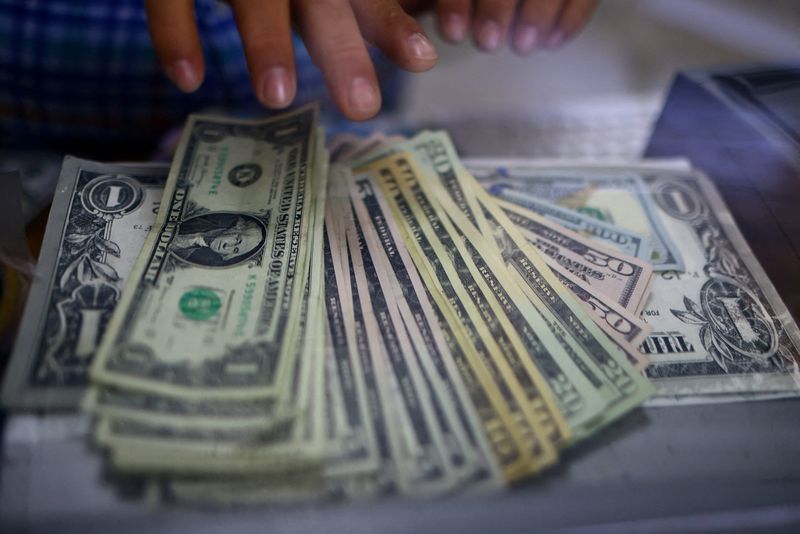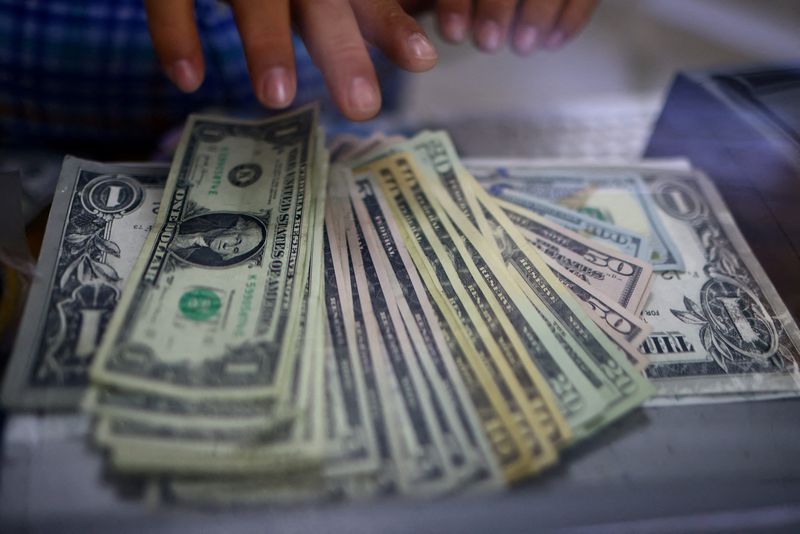Forex
Dollar gains after US consumer prices rise more than expected


© Reuters. FILE PHOTO: The employee of a currency exchange shop counts U.S. dollar banknotes in Ciudad Juarez, Mexico July 27, 2023. REUTERS/Jose Luis Gonzalez/File Photo
By Herbert Lash
NEW YORK (Reuters) -The dollar rose sharply on Thursday after U.S. consumer prices rose more than expected in September, lifted by an elevated cost of rent that raised the prospect of the Federal Reserve keeping interest rates high for some time.
The Labor Department’s report on Thursday showed the annual increase in consumer prices last month, excluding the volatile food and energy components, was the smallest in two years, but the surprise surge in rental costs rippled across markets.
While many shrugged off the move higher in rental costs, others concluded the Fed’s mission to lower inflation to it’s 2% target isn’t quite there.
“It just drives home the recent narrative that interest rates are likely to stay fairly high for a long period of time until the Fed can really break the back of inflation,” said Douglas Porter, chief economist at BMO Capital Markets in Oakville, Canada.
“Getting inflation back to 2% is not going to be easy.”
The consumer price index increased 0.4% last month, with a 0.6% jump in the cost of shelter accounting for more than half of the rise.
The , a measure of the U.S. currency against six others, jumped 0.85% to 106.550 in its biggest single-day gain since March 15. The dollar rose more than 1% against sterling, and the Australian and New Zealand dollars.
While a close call, the Fed is on course to hike rates one more time, most likely in December, said Bipan Rai, North America head of FX strategy at CIBC Capital Markets in Toronto.
The euro declined 0.85% to $1.0527, while the yen slid closer to breaching the 150 mark, seen as a level Japanese officials may intervene to halt the currency from weakening further. It was last down 0.43% at 149.81 per dollar.
Owners’ equivalent rent, a measure of the amount homeowners would pay to rent or would earn from renting their property, rose even though non-official sources show a decline in rental prices.
“Since the Fed makes its decisions based on the official numbers, not on what third party sources are showing, it’s a little bit worrisome,” said Thierry Wizman, Macquarie’s global FX and interest rates strategist in New York.
“Even though September was a blip, I don’t think that it negates the overall picture of the declining inflation. I don’t think that this is going to cause (the Fed) to hike,” Wizman said. “The only thing that the market is missing is that somehow it thinks that the Fed is going to drop high for long.”
The dollar’s recent weakness has been driven by declining Treasury yields as bond prices rallied on the Fed’s softer stance on future rate rises. Bond yields move opposite to their price. The yield on 10-year Treasuries rose 10.6 basis points (bps) to 4.7032%. The benchmark note hit its highest since 2007 last week at 4.887% but dropped sharply this week.
Also in the mix for currency investors on Thursday were sluggish British growth figures, which showed the economy partially recovered in August after a sharp drop in July. The pound initially did not significantly react but later fell 1.15% to $1.2174. The pound was the best performing G10 currency in the first half of this year, thanks to better-than-expected economic data and sticky inflation that drove expectations the Bank of England (BoE) would be increasing rates for longer than most peers. It then had its worst month in a year in September, as those factors reversed, before steadying this month. Thursday’s CPI release came after Wednesday’s mixed report on U.S. producer prices, and minutes from the Fed’s September meeting. Fed officials pointed to uncertainties around the economy, oil prices and financial markets as supporting “the case for proceeding carefully in determining the extent of additional policy firming that may be appropriate,” the minutes showed. The Swiss franc had been set to strengthen for the seventh successive session, the longest streak since July 2020. But the franc retreated, with the dollar up 0.72% at 0.9085.

 Forex3 years ago
Forex3 years agoForex Today: the dollar is gaining strength amid gloomy sentiment at the start of the Fed’s week

 Forex3 years ago
Forex3 years agoUnbiased review of Pocket Option broker

 Forex3 years ago
Forex3 years agoDollar to pound sterling exchange rate today: Pound plummeted to its lowest since 1985

 Forex3 years ago
Forex3 years agoHow is the Australian dollar doing today?

 Cryptocurrency3 years ago
Cryptocurrency3 years agoWhat happened in the crypto market – current events today

 World3 years ago
World3 years agoWhy are modern video games an art form?

 Commodities3 years ago
Commodities3 years agoCopper continues to fall in price on expectations of lower demand in China

 Economy3 years ago
Economy3 years agoCrude oil tankers double in price due to EU anti-Russian sanctions





















